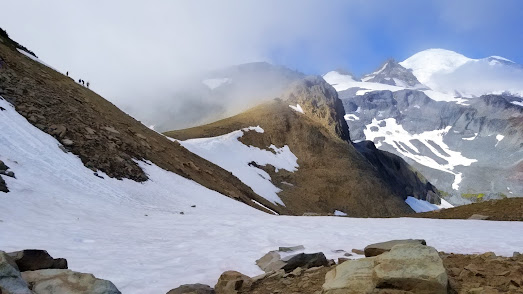I’ve
been writing a book since November of 2020 so I haven’t been on any of the bigger
hikes yet this year. The book is now complete and I’m more than ready to get
out. I wonder what it will be like out there in primetime of 2021.
Hiking during the ramp of Covid in
2020 was a cautious endeavor for me, always solo and mostly on trails less
traveled. I wanted to avoid people while getting my wilderness fix. Last year
the more popular trails were surprisingly crowded with people who rarely hike. I
took a chance on a couple of more popular hikes and promptly turned back to the
more obscure. I look back at my experiences hiking to Summerland and Panhandle
Gap on Mt. Rainier in the first week of August.
Raves: Summerland is a stunning hike
that provides small waterfalls along the forested entry trail and ever-changing
expansive vistas and visual beauty once you break out from the forest trail, especially
in the wildflower season. The Glacier Lilies have disappeared and many of the
other wildflowers are now past their prime and fading but others are still
abundant and serving up a visual feast. The real excitement begins with
glimpses of the mountains from the upper sections of the forested trail just
before you break out to cross the log bridge at Frying Pan Creek. The bridge
crossing signals the start of something wonderful as you ascend through
flowering alpine meadows which culminate with series of switchbacks through more
flowered high angled meadows up to the Summerland camp area, which features a
natural amphitheater with open wildflower meadows, a tumbling creek, rollicking
marmots and views of Meany Crest and Mt. Rainier. Curiously, there were no bugs
at all.
Ascending from the Summerland
meadows the scenery abruptly changes from lush meadows to a rocky glacial
moraine. Another log bridge fed by roaring glacier melts cascades across the
trail creating a dramatic environment where you will need to pause to take it
in. Even here, amongst the rocks, there are small patches of alpine flowers.
Pushing further on, the trail passes by glacial tarns before traversing a
cirque and crossing the remnants of snowfields to arrive at the gap. The
snowfield crossings on the way to the gap are very straightforward and you will
marvel at the views as you traverse this giant amphitheater. The diversity of
scenery from trailside waterfalls to wildflower meadows to snowfields sprawled
across steep rocky slopes is what makes this hike so unique.
Rants: Number 1: Thoughtless
people. A prominent sign greets hikers at the entrance to Summerland that
states: ‘Summerland is a fragile meadow that has received heavy use. You can
help preserve this special place. Stay on designated trails.’ And of course, on
descending from the gap and hiking through Summerland, I noticed three separate
couples lounging and lunching in the fragile meadows by the creek that runs
through Summerland. I took photos and mentioned them to a ranger that I
encountered by the shelter. He said he was just about to head up there and
would take care of it.
Number 2: Too many people, even
on a Friday. I didn’t count but it had to be in the hundreds with through-hikers, trail runners, and day hikers, many in larger parties from multiple
households, carpooling during a pandemic. Most hikers had and put on masks
and/or turned aside on the trail to respect physical distancing protocols,
which is heartening. However, too many younger men wore no masks and failed to
cover their mouth and nose, and simply hiked ahead without stepping off or
turning away, business as usual. Annoying.
After picking less popular hikes earlier
this season where I encountered very few people, I decided to revisit
Summerland for the sensational diversity and views. I discovered that dealing
with so many people was emotionally fatiguing, for me at least. This is my
fourth and probably the last hike of Summerland until we are again safe. I had been
thinking about repeating the hike from Paradise to Camp Muir, but after this
experience, I expect that the number of hikers would be even greater and the
best step for me will be to seek out the less known and less traveled wild
places.
Here are links to four spherical panoramas that I shot between 2015 and 2020. For best viewing click on the ‘Toggle Fullscreen’ icon in the panel in the upper right of the onscreen image. Then scroll to experience the immersive image.
Summerland Meadow Creek, Mt. Rainier National Park, WA State: https://www.360cities.net/image/summerland-meadow-creek-mt-rainier-national-park-wa-state
Summerland
Meadow, Mt. Rainier National Park, WA State: https://www.360cities.net/image/summerland-meadow-mt-rainier-national-park-wa-state-usa
Fryingpan Moraine Creek, Mt. Rainier National Park, WA State: https://www.360cities.net/image/fryingpan-moraine-creek-mt-rainier-national-park-wa-state
Panhandle
Gap, Mt. Rainier National Park, WA State: https://www.360cities.net/image/panhandle-gap-mt-rainier-national-park-wa-state-usa








